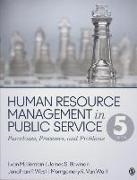Read more
Informationen zum Autor past University Chair Professor at National Chengchi University (Taipei, Taiwan), and a former policy analyst with the National Science Foundation. Klappentext Recognizing the inherent tensions and contradictions that result from managing people in organizations, Human Resource Management in Public Service: Paradoxes, Processes, and Problems offers provocative and thorough coverage of the complex issues of management in the public sector. Continuing the award-winning tradition of previous editions, this Fifth Edition helps students to understand complex managerial puzzles and covers all of the stages of the employment process, including recruitment, selection, training, legal rights and responsibilities, compensation, and appraisal. Extensive skill-building exercises help you practice and apply the material and develop hands-on, technical skills that will help you in the workplace. A broad range of examples from local, state, federal, and international settings provide you with examples of the issues in a variety of public sector contexts. Questions at the end of each chapter, along with a mix of individual, group, and in-class exercises, encourage active learning and mastery of concepts. Zusammenfassung Grounded in real public service experiences, the book emphasizes hands-on skill building and problem solving. Inhaltsverzeichnis Part I: Context and Challenges Chapter 1: The Public Service Heritage A Day in the Life of Maria Hernandez Some Challenges in Getting and Managing the Right People The Structure and Role of Human Resource Departments Historical and Institutional Context Reforming Government in the Clinton, Bush, and Obama Years Human Resource Management Principles Values, Ethics, and Moral Management Summary and Conclusion Chapter 2: Legal Rights and Responsibilities The Foundations of Employment Law The Employment Relationship Balancing Employer, Employee, and Societal Interests Privacy Issues Preemployment Investigations: Truth, Personality, Health, Credit, and Criminal Records Discrimination Summary and Conclusion Part II: Processes and Skills Chapter 3: Recruitment Factors in Recruitment: Employer and Applicant Perspectives Recruitment Steps Planning and Approval Position Announcements Recruitment Strategies Enhancing Recruitment Prospects: The Seeker's Perspective Summary and Conclusion Chapter 4: Selection The Bases and Origin of Selection Criteria in Selecting Selection Tests Selection: Four Screening Phases Initial Reviewing and Testing Interviewing and Reference Checks: Narrowing the Pool General Considerations for Those Conducting Interviews Choosing and Negotiation Postoffer and Hiring Issues Summary and Conclusion Chapter 5: Position Management Three Types of Personnel Strategies The Origins of Position Classification and Management Job Design and Job Analysis Job and Position Descriptions From Jobs to Job Systems Summary and Conclusion Chapter 6: Employee Engagement Pull, Push, or Drive? Human Resource Management and the Climate for Engagement Tools of Engagement Summary and Conclusion Chapter 7: Compensation Equity and Expectancy Theory Pay Determination Philosophy The Great Pay Debate Labor Market Forces: External Competition Job Content: Internal Consistency Individual Considerations: Fairness and Individual Contributions Implications Summary and Conclusion Chapter 8: Employee-Friendly Policies Workforce and Workplace Trends Family/Work Programs Health, Safety, and Wellness Programs Flexible Work Arrangements Keys to...

